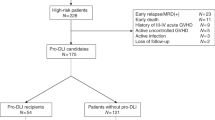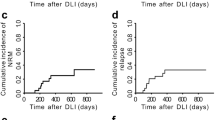Abstract
Purpose
We retrospectively evaluated the feasibility and safety of a modified prophylactic donor lymphocytes infusion (DLI) approach in advanced leukemia.
Materials and methods
Thirty-three patients with advanced leukemia received modified prophylactic DLI; that is, granulocyte colony-stimulating factor-primed peripheral blood progenitor cells instead of steady-donor lymphocyte harvests were used, and a short-term immunosuppressive agent (cyclosporine A or methotrexate 10 mg once per week for 2 to 4 weeks) was used for prevention of DLI-associated graft versus host disease (GVHD) after human leukocyte antigen-identical sibling hematopoietic stem cell transplantation.
Results
Thirty-nine infusions were performed in 33 patients. The mononuclear cells and median CD3+ cells infused for DLI were 1–2 × 108 and 0.93 × 106 per kilogram, respectively. Six patients experienced II–IV-grade acute GVHD. Twenty patients developed chronic GVHD. No GVHD-related death or transfusion-related pancytopenia was observed. With an 18-month median follow-up, 16 patients were in disease-free survival, and overall survival at 1 and 1.5 years was 69.0% and 50.2%, respectively.
Conclusion
The modified prophylactic DLI strategy might represent a step forward in the treatment of advanced leukemia.
Similar content being viewed by others
References
Huang XJ, Guo NL, Ren HY. An improved anti-leukemic effect achieved with donor progenitor cell infusion for relapse patients after allogeneic bone marrow transplantation. Chin Med J. 2003;116:736–41.
Huang XJ, Liu DH, Xu LP. Prophylactic infusion of donor granulocyte colony stimulating factor mobilized peripheral blood progenitor cells after allogeneic hematological stem cell transplantation in patients with high-risk leukemia. Leukemia 2006;20:365–8.
De Lima M, Bonamino M, Vasconcelos Z. Prophylactic donor lymphocyte infusions after moderately ablative chemotherapy and stem cell transplantation for hematological malignancies: high remission rate among poor prognosis patients at the expense of graft-versus-host disease. Bone Marrow Transplant. 2001;27:73–8.
Huang XJ, Chang YJ, Zhao XY. In vivo induction of T-cell hyporesponsiveness and alteration of immunological cells of bone marrow grafts using granulocyte colony-stimulating factor. Haematologica 2004;89:1517–24.
Chen SH, Li X, Huang XJ. Effect of recombinant granulocyte colony-stimulating factor on T-lymphocyte function and the mechanism of this effect. Int J Hematol. 2004;79:178–84.
Mengarelli A, Iori A, Guglielmi C. Standard versus alternative myeloablative conditioning regimens in allogeneic hematopoietic stem cell transplantation for high-risk acute leukemia. Haematologica 2002;87:52–8.
Zhou J, Guo NL, Zheng H. Comparison of two conditioning regimens in allogeneic bone marrow transplantation. Chin J Hematol. 1996;17:64–6.
Devergie A. Graft vs. host disease. In: Apperley J, Carreras E, Gluckman E, Gratwohl A, Masszi T, editors. Haematopoietic stem cell transplantation: the EBMT handbook. Rev ed. Paris, France: European School of Hematology; 2004. p. 168–9.
Durnam DM, Anders KR, Fisher L. Analysis of the origin of marrow cells in bone marrow transplant recipients using a Y-chromosome-specific in situ hybridization assay. Blood 1989;74:2220–6.
Anslinger K, Rolf B, Keil W. Evaluation and application of the AmpF/STR profiler plus PCR amplification kit in a Bavarian population sample. Int J Legal Med. 2001;114:278–80.
Edenfield WJ, Gore SD. Stage-specific application of allogeneic and autologous marrow transplantation in the management of acute myeloid leukemia. Semin Oncol. 1999;26:21–34.
Robak T, Wrzesien-Kus A. The search for optimal treatment in relapsed and refractory acute myeloid leukemia. Leuk Lymphoma. 2002;43:281–91.
Frassoni F. Stem cell transplantation in adults: acute leukemia. In: Apperley J, Carreras E, Gluckman E, Gratwohl A, Masszi T, editors. Haematopoietic stem cell transplantation: the EBMT handbook. Rev ed. Paris, France: European School of Hematology; 2004. p. 239–54.
Biggs JC, Horowitz MM, Gale RP. Bone marrow transplants may cure patients with acute leukemia never achieving remission with chemotherapy. Blood 1992;80:1090–3.
Ringden O, Horowitz M, Gale RP. Outcome after allogeneic bone marrow transplant for leukemia in older adults. JAMA 1993;270:57–60.
Singhal S, Powles R, Henslee-Downey PJ. Allogeneic transplantation from HLA-matched sibling or partially HLA-mismatched related donors for primary refractory acute leukemia. Bone Marrow Transplant. 2002;29:291–5.
Alessandrino EP, Bernasconi P, Caldera D. Chemotherapy and donor peripheral blood progenitor cells for acute leukemia in early relapse after allogeneic bone marrow transplantation. Bone Marrow Transplant. 1999;23:607–12.
Slavin S, Naparstek E, Nagler A. Allogeneic cell therapy with donor peripheral blood cells and recombinant human interleukin-2 to treat leukemia relapse after allogeneic bone marrow transplantation. Blood 1996;87:2195–204.
Levine JE, Braun T, Penza SL. Prospective trial of chemotherapy and donor leukocyte infusions for relapse of advanced myeloid malignancies after allogeneic stem-cell transplantation. J Clin Oncol. 2002;20:405–12.
Kolb HJ, Schattenberg A, Goldman JM. Graft-versus-leukemia effect of donor lymphocyte transfusions in marrow grafted patients. European Group for Blood and Marrow Transplantation Working party Chronic Leukemia. Blood 1995;86:2041–50.
Huang XJ, Liu DH, Liu KY. Donor lymphocyte infusion for the treatment of leukemia relapse after HLA-mismatched/haploidentical T-cell-replete hematopoietic stem cell transplantation. Haematologica 2007;92:414–7.
Sohn SK, Jung JT, Kim DH, Lee NY, Seo KW, Chae YS, et al. Prophylactic growth factor-mobilized donor lymphocyte infusion using cells reserved at the time of transplantation after allogeneic peripheral blood stem cell transplantation in patients with high-risk hematologic malignancies. Cancer 2002;94:18–24.
Huang XJ, Chang YJ, Zhao XY. Maintaining hyporesponsiveness and polarization potential of T cells after in vitro mixture of G-CSF mobilized peripheral blood grafts and G-CSF primed bone marrow grafts in different proportions. Transplant Immunol. 2007;17:193–7.
Pawson R, Potter MN, Theocharous P. Treatment of relapse after allogeneic bone marrow transplantation with reduced intensity conditioning (FLAG+/− Ida) and second allogeneic stem cell transplant. Br J Haematol. 2001;115:622–9.
Michallet M, Thomas X, Vernant JP. Long-term outcome after allogeneic hematopoietic stem cell transplantation for advanced stage acute myeloblastic leukemia: a retrospective study of 379 patients reported to the Societe Francaise de Greffe de Moelle (SFGM). Bone Marrow Transplant. 2000;26:1157–63.
Clift RA, Buckner CD, Appelbaum FR. Allogeneic marrow transplantation during untreated first relapse of acute myeloid leukemia. J Clin Oncol. 1992;10:1723–9.
Schmid C, Schleuning M, Schwerdtfeger R. Long-term survival in refractory acute myeloid leukemia after sequential treatment with chemotherapy and reduced-intensity conditioning for allogeneic stem cell transplantation. Blood 2006;108:1092–9.
Acknowledgment
This article is supported in part from Hi-tech Research and Development Program of China, Innovation Team Program of Ministry of Education of China, National Outstanding Young Talent Natural Science Foundation, Leading Program of Clinical Faculty accredited by the Ministry of Health of China.
Author information
Authors and Affiliations
Corresponding author
Rights and permissions
About this article
Cite this article
Huang, XJ., Wang, Y., Liu, DH. et al. Modified Donor Lymphocyte Infusion (DLI) for the Prophylaxis of Leukemia Relapse after Hematopoietic Stem Cell Transplantation in Patients with Advanced Leukemia—Feasibility and Safety Study. J Clin Immunol 28, 390–397 (2008). https://doi.org/10.1007/s10875-008-9193-4
Received:
Accepted:
Published:
Issue Date:
DOI: https://doi.org/10.1007/s10875-008-9193-4




